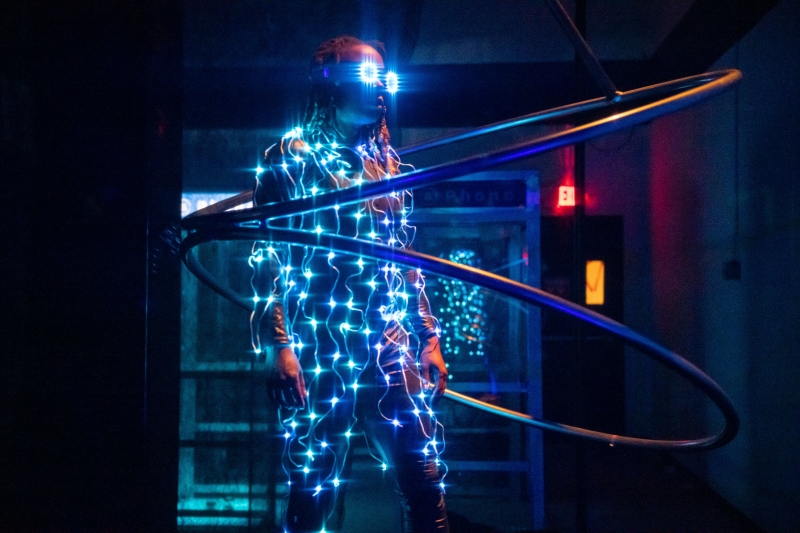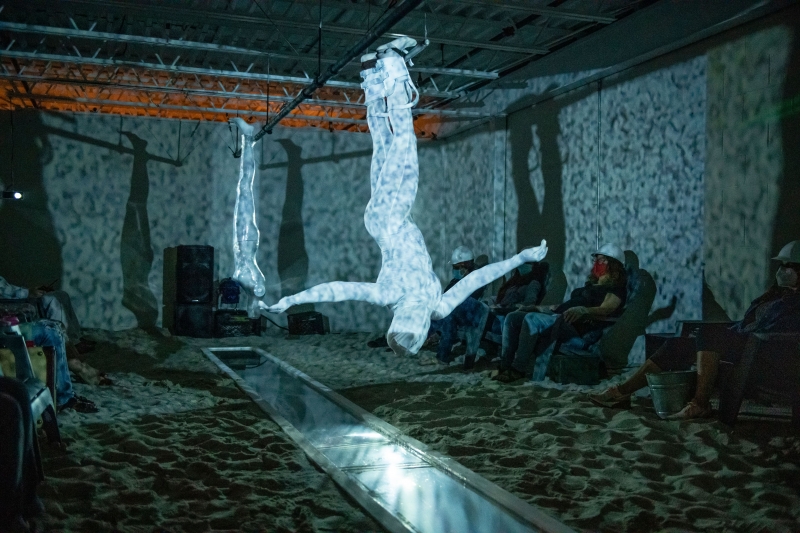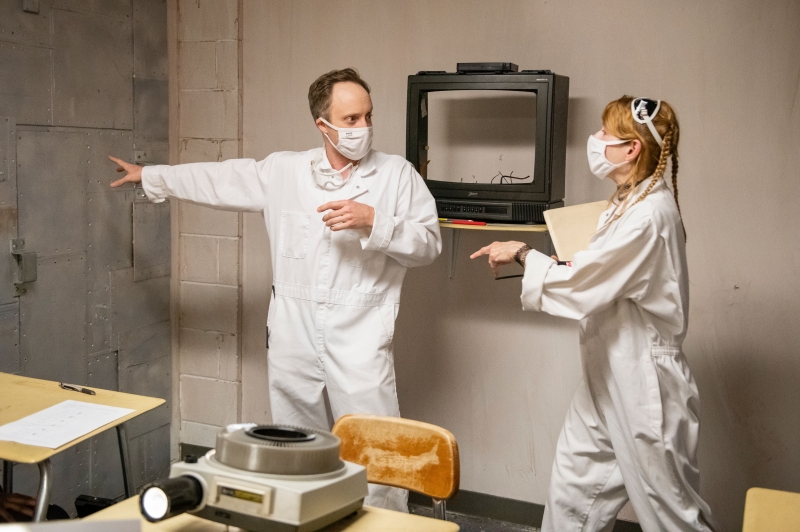BWW Interview & Review: Brian Sanders' DRAGONBUTTER Flies to the Top of Philly's List of Must-See Theatre
.

From da Vinci to the Wright brothers, humans for centuries have been intrigued by flight. Though we can fly via airplane, parasailing and even skydiving, how amazing would it be if we had the superpower of flight?
"The story in Dragonbutter, (which is a strongly story-driven experience) is about a mad-scientist of sorts trying to discover a way of flying by combining machine and animal I guess or human or we don't know exactly what. Inside of that, he does a lot of experimenting. And one of the things he experiments on to figure out different techniques for flying, kind of like Leonardo analyzing wings and trying to build a flying machine, he combines dragonflies and butterflies and ends up with a Dragonbutter."
But what is Dragonbutter?
I had the opportunity to virtually interview performance artist, choreographer and Dragonbutter inventor Brian Sanders.
"It is part game, part immersive escape room and performance, and story and theatre experience." Sanders explains.
Dragonbutter is a multi-sensory experience is an ambitious project set in an 8,000-square-foot warehouse located at 200 Spring Garden Street. Dragonbutter is spread out through multiple themed rooms featuring a stunning light and sound arrangement. Each room challenges players with mini-riddles, and dramatic physical performances, leading up to the finale, a final fight against the "Boss." Reminiscent of old-school video games, the story reveals itself in layers and begins when you and 11 other "players" enter the abandoned laboratory building, filled with haunting lobby music eerily playing through speakers. Next, players enter a decontamination chamber, left wondering what will happen next.
Sanders describes how the concept from the piece stemmed from his experience during the COVID pandemic. "The content and the design of the piece is a result of the last year and a half." He explained that like many others, he spent a lot of time home. "After six months of not being able to take it anymore, I went back into the studio and started working. I don't know what I was working on," he admitted.
Sanders explained that he was attempting to figure out the logistics of flight for some upcoming projects on the horizon. He became engulfed in the idea of it all. "I ended up becoming this little mad scientist that was literally trying to figure out how to fly. The idea of the mad scientist locked in a laboratory by himself and sort of creating his own amalgamations of his fantasy... that was the real life of it."
Dragonbutter is a plethora of ideas that, like a cacophony, though seemingly chaotic, combine to create a magical and unique experience. "I feel like there is something about tapping into the creative side of your brain: which for me is non-linear and very sort of open to suggestion and will dart in any direction at any whim and idea."
Like Sanders self-described brain, the layout of the warehouse as well as the plot itself is seemingly erratic but makes complete sense as the show progresses. Though 8,000 square feet seems like a lot of space, the warehouse is divided into a plethora of rooms creating a sort of labyrinth that audience members move through simulating different levels and locations of a video game.
The interactive nature of the piece creates an almost escape room feeling to the experience. When the audience reaches the "boss level" it feels like you are racing against the clock and fighting a challenge to escape. Along the way, the audience collects inventory and "points," but they also collect metaphorical clues that piece the overall puzzle together revealing Dr. Livingston's devious deeds.
Dragonbutter is not only a prime example of Sanders' creativity, but it is a love-letter to vintage science fiction films. "I had fun sort of underscoring everything with several references to sci-fi movies from the 80s." Sanders says. The soundscape definitely gives a nod to Stranger Things and, like the modern Netflix show, the spirit of Dragonbutter lives in the past, and even literally lives in a disused warehouse that has been mostly abandoned since the 80s.
Dragonbutter is a prime example of site-specific theatre. The piece was created to be specifically performed in this location and everything about the warehouse where this piece is performed lends itself to enhancing the overall experience of the show.
Sanders successfully simulates flight so beautifully in Dragonbutter, using creative choreography and stunning structures to utilize vertical space in a way I have never seen before in immersive art. There is an exclusivity and intimacy to the performance. The show revolves around direct interactions with not only the performers, but other audience members and the environment as well.
I specifically love the design and concept of the "Chaos Chamber" where, sitting with your toes in the sand, the audience listens to a guided meditation while watching an almost eerily mesmerizing acrobatic performance.
"While I can't go to the museum, one of my favorite things to do is go to walk around the museum with my headphones on and put music to visual art and create soundtracks to things, and I couldn't do that, so I was a t home experiencing video game art. So, the types of art that we are able to experience and be inspired by, I believe kind of inform what the next probably year and a half to two years of art are going be like. It's going to be different. As an aftershock of it all."
Dragonbutter completely tears down the theatrical "fourth wall". It feels like living in a sci-fi video game with the appropriate amount of thrilling, terrifying and entertaining.
"I set out to want to give the audience the experience of a role-playing game (or RPG), an avatar inside a game. They can experience all the fun the performer is having as a vicarious avatar." Sanders says. "I looked up a lot of game design while I was putting all this together."
Sanders says, "There's a sort of multi-track portion of the experience. You can play at any level of depth. You can play by going really slow in detail or you can go right for the boss-kill. And there is a boss fight. Don't you worry. "
The Boss Fight Sanders refers to is the climax of the play where the audience faces the titular Dragonbutter itself. Your weapon of choice for your survival is, of course, determined based on the amount of points you accumulate by collecting inventory, choosing your case at the beginning wisely, solving riddles, disabling lizard-like experiments, and being involved in the overall experience. Your weapon to defeat the Dragonbutter is only one of the rewards audience members unlock with having higher scores.
Dragonbutter gets better the more hands-on you are and interacting with the tasks and performers completely heightens the experience. I also suggest you listen to the performers' suggestions and that you immediately suit up in the poncho and gloves provided at the top of the show.
Dragonbutter also timely, being well-suited for audience members emerging from quarantine. Sanders explains that he took COVID regulations into consideration when creating the piece. "How do I create an experience for what I thought would be a lot of people that could move around at the same time safely? How can I create a smaller audience experience?" He tells of how he wanted "a tighter-knit group of people experiencing something together."
"I like to say a lot of the times, expect the unexpected. But what the heck does that mean?" He goes on to explain that audiences that view Dragonbutter should "have an open mind. Expect it to be fun or funny, exciting, scary, tense at times, very creative, fun in a group too. While it is a small group. It is fun with friends and family. "
Dragonbutter is an explosion of sensory experience and is almost gut-wrenchingly beautiful in its aesthetic, amazing soundscape, and ingenuity. As much fun as Sanders describes in creating the piece, I had just as much fun experiencing it. Dragonbutter is completely ingenious and transforms a neglected warehouse into the epitome of Sanders' imagination.
"This is the perfect piece to get out of yourself" Sanders says, telling me its "Extremely relevant but in a wonderfully fantastical way... It helps us get out of ourselves and take an hour out of our day to find a sense of creativity, fantasy, a little bit of hope, and a really great time."
Overall, Dragonbutter is visceral, visual, and aurally astounding, combining a multitude of entertainment from aerial arts to dance to theatre to game-design into a unique and ultimately effective theatrical experience, that I can guarantee, is like nothing you've seen before.
"It gives an experience that give people a sense of excitement with a touch of hope and elation. They take away a good positive feeling."
Dragonbutter is recommended for children 13 and older. Tickets are selling fast, and performances have a limited capacity of 12 people per show so grab your tickets soon. The show runs now through July 26th, and will restart as a part of Philly Fringe, running September 2nd to October 3rd.
For more information about the show please visit https://www.briansandersjunk.com/dragonbutter
Reader Reviews

Videos
